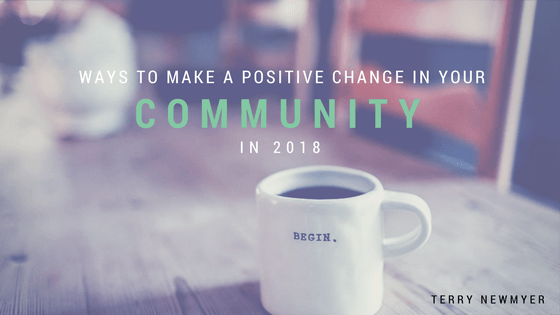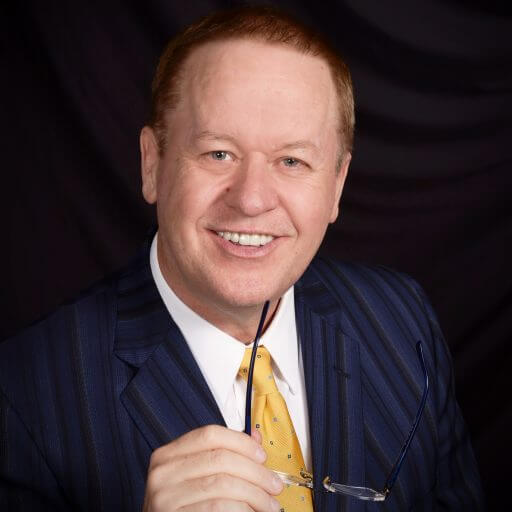
Ways to Make a Positive Change in Your Community in 2018
Most of us want to make a difference in our communities. At the start of each year, we take a look at ourselves and consider things we should start doing, vices we should stop doing, and ultimately make a list of resolutions. Unfortunately, this list starts to fall by the wayside as the month’s press on, but making a difference through charitable contributions, be it through volunteering or by sending a check to a philanthropic organization should hold strong through the year. The following list is comprised of ideas of small and big things you can do throughout the year that would truly make a difference in your community.
Donate your stuff
As the weather warms up this year, you’ll probably do a bit of spring cleaning around your house. While you deep clean your home, consider getting rid of anything you don’t necessarily need anymore. Maybe you have an old sofa that rarely gets used or boxes of your children’s old clothing they haven’t been able to wear for years. Rather than holding on to these possessions, give them to a charity in your community. The old couch you have might make a great addition to a charity that helps people transition from homelessness, and the children’s clothing is always welcomed at shelters for women and children.
Help with wish lists
While you’re donating your old belongings to charities in your area, talk to the office to see what items are on their wish lists. Most charities have a list that has everything they need to acquire in order to keep helping individuals like cleaning supplies, bedding, or food. If you have the means, get ahold of one of these lists and get to shopping. The charity will be eternally grateful for any help you can provide them, and these items allow them to keep their doors open and focus their money on projects.
Use your professional skills
As a working professional, you have invaluable information about building a career, even if you don’t think so. For those seeking employment, they often turn to organizations within their own community that help with career development. Within these organizations, they help individuals build a resume, learn networking skills, set up professional profiles, and help with interviewing. Contact your local career development center to see if they need help setting up seminars or coming up with informative packets to hand out to people who come in.
Help the elderly
Our elderly citizens are often overlooked when it comes to serving the community. Unfortunately, some elderly men and women who live in nursing homes don’t get as many visitors as others and are alone with the exception of other residents and the staff. Sacrifice a few hours a month to visit a nursing home in your area and you’ll see the positive effect it has on someone’s life.
Buy local
America’s small businesses are the backbone of the community and buying from them only strengthens the economy of your area. When you pick up your prescription from a local pharmacy or buy products from your local hardware store, the money you spend goes directly to the families that own the business and they can reinvest it back into the community. Oftentimes, the allure of the big box stores is their ability to offer discounts and low prices, but the money is best spent in local companies that keep the whole community going.
Volunteer for a hotline
Hotlines are incredibly useful tools that help save countless numbers of lives throughout the year. There are many different hotlines across the country each for a different cause like suicide prevention, child abuse, addiction, or even just as a place to talk to someone who will listen. These hotlines are often answered by volunteers who care enough to talk to people who need to talk. If this sounds like something you can handle, contact the organization you’d like to volunteer at so you can make a difference in the lives of people who are in a crisis situation.
Pay for a student’s lunches
Going without food is a terrible idea, but unfortunately, it’s a true reality for many children in communities across the country. Save money throughout the month by limiting the amount of money you spend on food out and contribute that money towards a student’s lunch debt. Students whose parents can’t afford to pay for lunches or are behind on their payments can be denied lunches from the school. Call a school in your community and offer to pay the debt for a student or several students so they don’t need to worry about not having a meal in the middle of their day.
Pick up trash
Keeping our communities clean helps everyone feel more comfortable and keeps the environment as healthy as possible. Take a plastic bag with you whenever you visit a park or even just walk around the neighborhood. Getting litter off of the streets and into the garbage will help keep it away from the community’s water supply or wildlife in the area.
Being an active member of your community by adopting one or multiple ideas on this list will definitely make a difference in the lives of those who need help the most.

Why Friends Should Never Ask Friends for Donations
Back when I was a CDO I invited a generous community member to make a $100,000 gift for his local hospital. When he pushed back from his ravioli entrée and said “yes,” I expected a moment of cheerful celebration.
Instead, the donor immediately added these words: “But do not ever ask me to ask anyone else for a gift.”
His message made the moment awkward. I responded by saying that there must be a story behind his conviction about not asking friends.
He went on to tell me that a few years earlier a local organization he supported enlisted him as a campaign chairman to raise $100,000 for club improvements. They told him it would be an easy assignment: All he needed to do was pledge $10,000 himself and then invite nine of his friends to do the same.
He lost friends through the process. He described it as just awful to go to friends and have them turn their backs on him and later not want to speak to him.
I empathized, saying, “While we will never request that you ask for a gift, are you willing to suggest folks that we should be asking?” I added: “If so, would it be OK to have them know that you have given?”
The donor quickly said this approach would be no problem. “I am comfortable being on the team,” he said. “I just do not want to ever again ask my friends to make gifts.”
His unfortunate experience in the friends-asking-friends-for-money department isn’t necessarily the norm. Indeed, development professionals who have been in the business for a while know that such asks, when handled right, can be powerfully effective. Something was clearly amiss in the donor’s approach with his friends. Perhaps that particular campaign didn’t provide solid training and processes. We can only guess at what went wrong.
But we don’t have to guess about the broader truth of this donor’s experience. The truth is: Many people do not feel comfortable asking their friends for money.
And yet it is those very people – friends of your board members, campaign volunteers and engaged donors – who are some of your best potential prospects.
This can be a real dilemma.
Fortunately, the team approach based on Malcolm Gladwell’s best-selling book, The Tipping Point, is a good solution. It allows a more effective process in which friends simply introduce the opportunity for giving to their friends but are not be expected to close the gift by making the formal solicitation.
In this scenario, a board member, campaign volunteer, physician, executive – or simply an engaged donor – plays the role of Connector. This Connector introduces his or her friend to the staff development professional with whom the Connector is working. From this point forward, the Connector can be as much or as little engaged in the process and with the development team as is comfortable for him or her.

Healthcare, Meet Philanthropy
The rising tide of healthcare costs will soon reach a head. National healthcare expenditures (NHE) totaled around $3 trillion in 2013, and there seems to be no sign of it slowing down. In fact, the Center for Medicare and Medicaid Services (CMS) projects health care costs to rise at a rate of about 5.8 percent each year during the 10 year period from 2014-2024. On top of that, the growth rate of those rising health care costs during that time is expected to be about 1.1 percent greater than GDP. Eventually, health care costs will compose almost a fifth of total GDP.
That’s a lot to digest. The long and short of it is that health care is costing us. A lot.
Now, before we get any deeper, we’re going to have to address the elephant in the room: politics. Healthcare is a deeply politicized issue. After all, it has been a major target of reform during the Obama administration. Today, it is debated on the national stage by those on the left and the right who hope to be his successor. Civil debate and argument is a defining feature of American politics, and we should encourage an open and honest dialogue with those who agree with and oppose our views. But here’s the thing— healthcare costs don’t tow a party line. Even if, suddenly, taxpaying citizens were no longer expected to pay a single dime for healthcare, the price remains the same. Costs don’t disappear like magic by the thud of Congress’s gavel or the stroke of the executive’s pen; it does, however, become a matter of who’s paying for it. That, friends, is a decidedly political question for another post for another time.
But why is such a cost surge on the horizon? In the opinion piece “The coming tsunami will radically change healthcare philanthropy— will you be ready?”, Steven A. Reed explains that it has to do with rapidly changing demographics. In short, the Baby Boomers who made up a large part of the workforce are approaching an age at which health care costs shoot up, and Gen X-ers (millennials) are going to have to foot the bill. However, today’s generation is experiencing a lower birth rate that has resulted in about nine million fewer people than their parents’ generation. Fewer working people means less tax revenue, so when the bill arrives, the entire generation will come up short. This is an impossible task of Penrose proportions not because the millennial generation is lazy, but “because it doesn’t have the critical mass.”
So what are we to do? This is the moment, Reed argues, that philanthropy comes in. We need to embrace the American spirit of giving, and take joy in reaching out and giving back. We have a collective desire to see everyone happy and healthy, and we should do our best to make that happen. We need to fundraise, and quite a bit— more than twice as much, in fact.
For those of us who may be concerned about our organization’s ability to raise that many funds, Reed directs us to the Association for Healthcare Philanthropy’s Healthcare Philanthropy Journal. The Spring 2014 issue presented data proving that an organization’s fundraising expenditure budget was the greatest predictor of fundraising success. Or more simply, “the more you spend, the more you make.”
Now’s the time for us to reassess our organizations’ giving habits. Are we giving because we’re expected to? Because it makes us feel good? Those are two popular reasons, yes. But maybe we should think about giving as a duty. Charged with the task of assisting our countrymen, we can take on any economic threat.
About Terry Newmyer
In 2013, Terry Newmyer came to Florida and opened the Strategies Now office, where he delivers marketing strategies to clients and works across multiple industries to support growth and development to achieve the projected results of their vision.
Early Career and Healthcare
Soon after receiving his Master’s degree at Andrews University, Terry became the Senior Vice President of the Lakeland Regional Health System in St. Joseph, Michigan, where he was responsible for marketing, planning, communications, managed care, education, physician services, and foundation management. Between 1988 and 1994, Terry helped increase the system-wide revenue from $65 million annually to $250 million. Terry later moved to Dallas and worked as a consultant for KPMG LLP, National Strategy Practice, where he started as a Manager and became a partner. There, Terry was responsible for launching a new consulting office that within two years of opening included twenty consultants and was achieving $10 million of annual revenue.
Terry Newmyer went on to found Strategies Now Inc., where he now serves as Managing Director. Terry then moved to Florida, where he resides today, to continue his work at Florida Hospital as the Senior Vice President of Business Development and Chief Development Officer. One achievement at Florida Hospital included securing sixteen new alliance contracts worth over $90 million of net value to the Hospital with various Fortune 500 companies such as GE, Walt Disney World, Olympus, and Nike. In 2007, the company completed a $100 million fundraising campaign over a year ahead of schedule and the following year exceeded the goal by $30 million.
Terry Newmyer was eventually offered a position as the President and CEO of Northern California Network Adventist Health in California and was responsible for the management of five different hospitals. During his tenure, the flagship hospital, St. Helena Napa Valley, earned the designation from NRC Picker for being the hospital in the Western USA with the highest overall patient satisfaction and received five-star recognition from Health Grades in twelve different service lines.
Education
Terry attended Atlantic Union College in Massachusetts for his undergraduate studies, where he received of Bachelor of Science in Business Administration and was awarded distinguished honors as a cross scholar. Upon graduation, he attended Andrews University in Michigan for his Master of Business Administration with an emphasis in marketing.
At Andrews University, Terry Newmyer was the Coordinator of Student Labor and housing, the Director of Marketing and Student Financial Services. He was also the President of Andrews Industries. Terry was responsible for various ranges of tasks, including managing a student apartment complex, networking both in and outside of the college community, keeping records of student finances, and managing diversified enterprises at Andrews University. As the President of Andrews Industries, Terry Newmyer was responsible for six businesses that that included a furniture factory, printer, bindery, retail plaza, motel, and an electronics company.
Strategies Now, Inc.
Case Studies of Strategies Now, Inc.
Strategic Positioning: Coordinating Your Relationships and Assets to Improve Your Key Metrics and Yield
Case Studies:
Revenue Growth: Drive Growth through Your Product Portfolio Decisions, Communications, and Intended Market Reach
Case Studies:

Philanthropy: Significant Wealth is Achievable from Fundraising Initiative through High-Synergy Teamwork
Case Studies:

Management Outsourcing: Secure Management for New Ventures or Small Business without Compromising Excellence
Case Studies:


